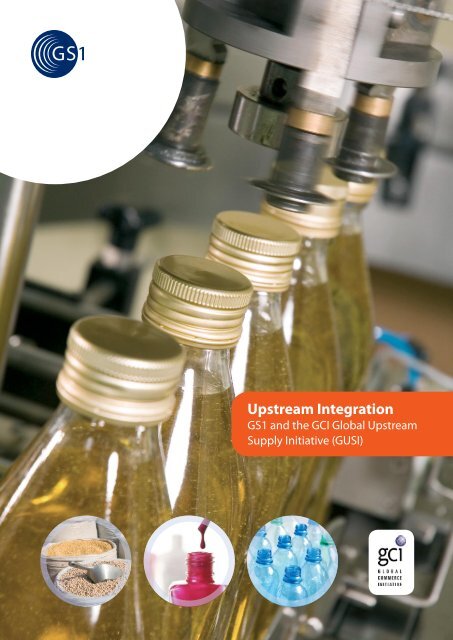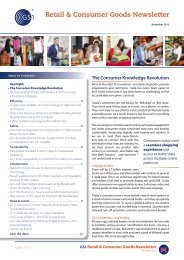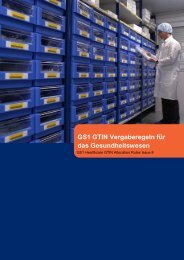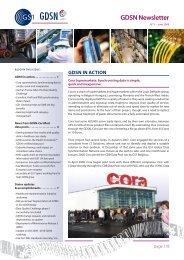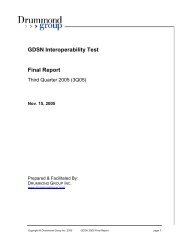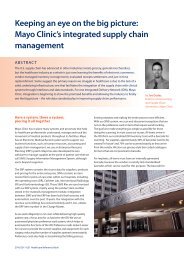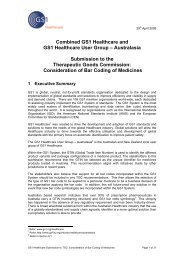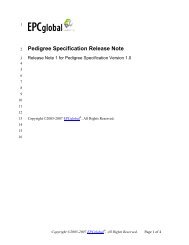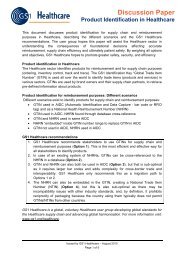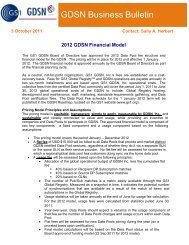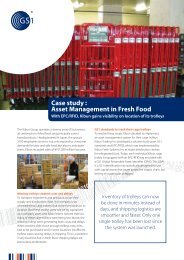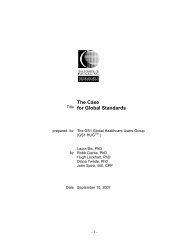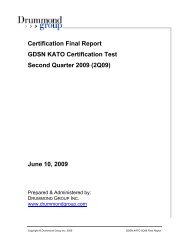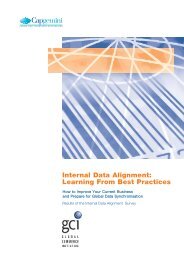Upstream Integration - GS1
Upstream Integration - GS1
Upstream Integration - GS1
Create successful ePaper yourself
Turn your PDF publications into a flip-book with our unique Google optimized e-Paper software.
<strong>Upstream</strong> <strong>Integration</strong><br />
<strong>GS1</strong> and the GCI Global <strong>Upstream</strong><br />
Supply Initiative (GUSI)
What’s<br />
<strong>GS1</strong> <strong>Upstream</strong> <strong>Integration</strong>?<br />
<strong>GS1</strong> <strong>Upstream</strong> <strong>Integration</strong><br />
is the <strong>GS1</strong> solution to address<br />
the challenges in the integration<br />
of the supply chain between<br />
manufacturers and their<br />
suppliers. <strong>Upstream</strong> <strong>Integration</strong><br />
is about improving the processes<br />
by sharing information and<br />
improving visibility of demand,<br />
demand changes and inventory.<br />
This will increase responsiveness to<br />
the manufacturing requirements<br />
and ultimately to the final<br />
consumers.<br />
SUPPLIERS MANUFACTURERS<br />
RETAILERS CONSUMERS<br />
UPSTREAM<br />
INTEGRATION<br />
Supply<br />
Plan Sales &<br />
Marketing<br />
Manufacturers Retailers<br />
Figure 1: The <strong>Upstream</strong> <strong>Integration</strong> (Source : GCI)<br />
Evolution of the market<br />
The market has changed: there are more and more products<br />
available for the consumers but also often in smaller<br />
quantities. The time between design and delivery to final<br />
consumer is expected to be shorter and shorter. This puts<br />
pressure on the upstream part of the chain and explains<br />
the need for integration, more reliability of the information<br />
flow and visibility of the physical flow (Figure 1).<br />
This is specifically true in the Consumer Packaged Goods<br />
Industry. The Global <strong>Upstream</strong> Supply Initiative (GUSI) was<br />
formed to address these challenges.<br />
How GUSI has been created<br />
In 2003, a group of manufacturers of Consumer Packaged<br />
Goods and their suppliers decided to define a common way<br />
to provide tighter integration of their supply chains. Their<br />
objective was to avoid costly and time-consuming IT integration<br />
projects with every manufacturer or supplier. At the<br />
end of 2004, the Global Commerce Initiative (GCI) initiated a<br />
new working group which incorporated the already-active<br />
GUSI members. The GUSI Working Group was born. It has<br />
developed and maintains the <strong>Upstream</strong> <strong>Integration</strong> Model<br />
(UIM) – the standardised processes and data interchanges<br />
underpinning upstream integration.<br />
<strong>GS1</strong> contribution<br />
<strong>GS1</strong> has supported the initiative on implementation of the<br />
UIM notably for:<br />
• tailoring the <strong>GS1</strong> standards for item identification and<br />
electronic communication,<br />
• supporting the developement of the message<br />
implementation guides,<br />
• providing assistance for<br />
implementations.
The benefits<br />
of implementing <strong>GS1</strong> Standards<br />
in combination with GUSI<br />
Some of the world’s largest consumer packaged goods<br />
manufacturers and their suppliers have identified significant<br />
benefits in using standard solutions.<br />
The companies reported:<br />
• Faster integration:<br />
up to 75% reduction in the time taken to connect to<br />
new partners<br />
• Reduced IT costs:<br />
- Set-up: reduced development and training costs<br />
(both IT and business staff)<br />
- Maintenance: due to phasing out of multiple<br />
non-standard interfaces<br />
• Larger scope:<br />
increased ROI by being able to implement across<br />
a larger scope of factories and suppliers. GUSI is for<br />
large and small companies.<br />
Supply Chain<br />
Optimisation<br />
Industry<br />
standard<br />
Share<br />
experience<br />
with<br />
community<br />
Scaling<br />
Benefit x Number of connections = improved ROI<br />
Figure 2 : X-factor schema (Source : GCI)<br />
Therefore, GUSI works as a multiplier to help achieve<br />
collaboration benefits in the following areas:<br />
• Service (product availability, lead time)<br />
• Administration (forecasting, order processing,<br />
financial settlement, data management)<br />
• Operation (physical receipt, manufacturing,<br />
change-over, truck fill-rate,…)<br />
• Financial (working capital, inventory)<br />
The adoption of the <strong>Upstream</strong> <strong>Integration</strong> Model allows<br />
companies to translate their internal processes and<br />
approaches into a common language that all other parties<br />
can use. As more companies adopt GUSI <strong>GS1</strong> standards, the<br />
more rapidly the overall benefits rise (Figure 2).
What<br />
is available?<br />
A business process model:<br />
the <strong>Upstream</strong> <strong>Integration</strong> Model<br />
For the Consumer Packaged Goods industry, the GUSI<br />
working group supported by <strong>GS1</strong> has successfully designed<br />
a business model known as the <strong>Upstream</strong> <strong>Integration</strong><br />
Model (UIM), and decided to adopt the <strong>GS1</strong> XML message<br />
standards to exchange information between the trading<br />
partners in support of these supply chain processes.<br />
The UIM creates a common approach and language for<br />
the business processes and data interchanges between<br />
manufacturers and their suppliers. It has been designed to<br />
cover the following business areas:<br />
Procurement, Material forecasting,<br />
Inventory management, Dispatch,<br />
Receipt, Consumption of Materials<br />
and Financial Settlement.<br />
The UIM is a modular solution which<br />
covers the “plan to cash” process for<br />
the two most used procurement<br />
scenarios:<br />
• “Traditional Order Management<br />
(TOM)” is the “manufacturerdriven”<br />
scenario. The demand line<br />
is initiated by the manu-facturer<br />
and sent to the supplier.<br />
• “Supplier Managed Inventory<br />
(SMI)” is the “supplier-driven”<br />
scenario. The supplier recommends<br />
or establishes the deli-veries to the<br />
manufacturer based on the manufacturer<br />
inventory data and or<br />
consumption forecast.<br />
The concept of the model is based on six building blocks.<br />
Together, the six building blocks create a modular solution<br />
to assist defining and driving the implementation of<br />
upstream integration.<br />
As shown in Figure 3, the UIM establishes clear links<br />
between each group of business processes and the<br />
interchange of the relevant data for these processes.<br />
<strong>GS1</strong> Standards<br />
<strong>GS1</strong> standards for identification (GTIN, GLN, SSCC, <strong>GS1</strong><br />
Logistic Label) support the model. From the eCom Standards<br />
only the XML syntax is supported in the exchange of information<br />
between the trading partners in support of these<br />
supply chain processes.<br />
To cover all upstream transactions, 15 messages have been<br />
selected from the <strong>GS1</strong> XML standards (Figure 4).<br />
To help implementation of the standards, supporting<br />
guidelines are available:<br />
• GTIN allocation rules including<br />
specific rules for ingredients, raw<br />
materials and packaging,<br />
• UIM implementation guidelines per<br />
building block including Message<br />
Implementation Guides (MIG’s).
Building Blocks Manufacturer Process Transactions Supplier Process<br />
<strong>Integration</strong> Agreement<br />
Data Alignment<br />
Purchasing Conditions<br />
Demand & Supply Signals<br />
Despatch Receipt & Consumption<br />
Financial Settlement<br />
Agree on Business Rules<br />
Maintain Master Data<br />
Agree Purchasing Conditions<br />
Report Inventory<br />
Gather Material Requirements<br />
Integrate Information<br />
Await Shipment<br />
Receipt of Goods<br />
Check Goods<br />
Consume Goods<br />
Invoice Receipt<br />
Create Self-Billing Invoice<br />
Invoice Con�rmation<br />
Create Remittance Advice<br />
Initiate Payment<br />
Building Blocks <strong>GS1</strong> XML messages<br />
Master Data Alignment Item Data Notification<br />
Purchase Conditions Purchase conditions<br />
Demand & Supply Signals Inventory Activity or Inventory Status<br />
Multishipment Order<br />
Order Response<br />
Goods Requirements<br />
Goods Requirements Response<br />
Replenishment Request<br />
Replenishment Proposal<br />
Despatch, Receipt Despatch Advice<br />
& Consumption Receipt Advice<br />
Financial Settlement Invoice<br />
Consumption Report<br />
Invoice Response<br />
Settlement<br />
Figure 4: Building blocks and GUSI XML messages association<br />
<strong>Integration</strong> Agreement<br />
Item Master Data<br />
Purchase Conditions<br />
Inventory<br />
Purchase Order<br />
Net Requirements<br />
Consumption Forecast<br />
Replenishment Forecast<br />
PO/Net Requirements Con�rmation<br />
Delivery Plan<br />
Despatch Noti�cation<br />
Physical shipment of goods<br />
Receipt Noti�cation<br />
Consumption Report<br />
Invoice<br />
Self-Billing Invoice<br />
Invoice Con�rmation<br />
Remittance Noti�cation<br />
Physical Payment<br />
Agree on Business Rules<br />
Maintain Master Data<br />
Agree Purchasing Conditions<br />
Report Inventory<br />
Plan Production & Supply<br />
Con�rm Delivery<br />
Pick & Pack goods<br />
Shipment<br />
Goods Receipt Noti�cation<br />
Consumption Noti�cation<br />
Create Invoice<br />
Invoice Receipt<br />
Invoice Con�rmation<br />
Payment Noti�cation<br />
Payment Receipt<br />
Figure 3: The UIM (Source: The “UIM” version 3.0)
The <strong>GS1</strong> documentation<br />
and Services<br />
Many manufacturers with their main suppliers have already<br />
implemented the UIM and its associated <strong>GS1</strong> standards, but<br />
now they need the support of <strong>GS1</strong> to speed-up the roll-out.<br />
In this context <strong>GS1</strong> is committed to support companies in<br />
their implementation.<br />
This will be provided as a package of implementation material<br />
(e.g. brochure, implementation guide with case study for<br />
each message, slides,...) and services (e.g training sessions,<br />
online support, GUSI <strong>GS1</strong>_XML message testing and logistic<br />
label testing,...). This package has been created in close<br />
collaboration between GCI and <strong>GS1</strong>, and will be available<br />
for users at their local <strong>GS1</strong> MO.<br />
GUSI users’ statements<br />
CROWN Europe, Roland DACHS<br />
(Vice president Logistics & Planning, GUSI Co-Chair):<br />
“GUSI is an Industry <strong>Integration</strong> Solution built on common<br />
processes and standards that will enable scaled benefits for<br />
trading partners.”<br />
NESTLE, Garry HAWORTH<br />
(Head of eBusiness, GUSI Co-Chair):<br />
“It is important to note that the benefits of the robust GUSI<br />
set of standards do not only occur in the upstream, they also<br />
flow to the downstream where customers and consumers<br />
are also beneficiaries.”<br />
UNILEVER, Peter ERNSTING<br />
(Senior Vice President Supply Chain Europe):<br />
“GUSI is about simplifying the connections of Supply Chain<br />
between manufacturers and suppliers. This improves<br />
service and reduces cost by eliminating the non-added<br />
value- the ultimate basis for sustainable profitable growth.”
Training Sessions<br />
• Two different inter-company<br />
training sessions (½ day per<br />
seminar).<br />
• First seminar: Introduction<br />
to the UIM and to the <strong>GS1</strong> XML<br />
standard.<br />
• Second seminar: How to<br />
understand the <strong>GS1</strong> XML<br />
message testing. Study of the<br />
<strong>GS1</strong> XML message structure<br />
and case studies.<br />
• Target audience:<br />
Manufacturers and suppliers<br />
with a business process<br />
orientation (first seminar) or a<br />
technical orientation (second<br />
seminar) and IT services<br />
providers.<br />
�<br />
Manual for implementing the UIM<br />
and <strong>GS1</strong> standards<br />
• A manual to understand the UIM standard.<br />
• A manual to support the implementation of messages<br />
exchanged in each ”building block”.<br />
• A manual with implementation guidelines for each message.<br />
<strong>GS1</strong><br />
Documentation<br />
& Services<br />
�<br />
Testing of Logistic labels and XML messages<br />
�<br />
• Testing of logistic label: The “code testing” department of<br />
<strong>GS1</strong> will be in charge of testing logistic labels and will deliver<br />
conformity diagnosis.<br />
• Testing of <strong>GS1</strong> XML messages: Three different levels<br />
of <strong>GS1</strong> XML message testing testing will be offered by<br />
the <strong>GS1</strong> eCom department (syntax testing, functional<br />
message testing, scenario testing based on early adopter’s<br />
implementation scenarios).<br />
�<br />
Online Support<br />
• For phone support, please<br />
contact your local <strong>GS1</strong><br />
member organization :<br />
http://www.gs1.org/contact/<br />
worldwide.php<br />
• E-mail address dedicated to<br />
the project for each <strong>GS1</strong> local<br />
member organisation<br />
• To provide communications<br />
means to users for technical<br />
support (technical questions<br />
on processes, messages<br />
implementation) or for<br />
messages and labels testing<br />
and approval.
Companies and organisations<br />
involved<br />
The following companies are GUSI members or supporters<br />
(Source: GCI, 2007)<br />
Ajinomoto, Alcan Food, Alcan Packaging, Avebe, Augustin,<br />
BASF, Coca-Cola Company, Constantia Flexibles Holding<br />
Gmbh, Crown Europe, Danisco, Darégal, Dow Corning, DSM,<br />
Elpack S.A, Euroma, Firmenich, Georgia Pacific Corporation,<br />
Givaudan, Groupe Danone, GundLach Verpacking, GundLach<br />
Verpackung, H.J. Heinz, Heineken, Henkel, Huhtamaki,<br />
International Flavours&Fragrances (IFF), IOI Group, J.M.<br />
Smucker Company, Jokey plastic Gmbh, Kellogg’s, Kimberly-<br />
Clark Europe, Kraft Foods, L’Oréal, Mayr-Melnhof Karton<br />
Gmbh & Co Kg, National Starch, Nestlé, Novozymes, Philips<br />
Lighting BV, Procter & Gamble, Quest International, Royal<br />
Sens, RPC Bebo Plastic, SaaleMühle Alsleben Gmbh, Sara<br />
Lee/De, SCA Packaging, Smurfit Kappa Group, Symrise, Tetra<br />
Pak International SA, The Dow Chemical Company, Unilever,<br />
Van Genechten Packaging, Wart, Zentis.<br />
GCI, the Global Commerce Initiative, is a global organisation<br />
that brings manufacturers and retailers together to identify<br />
opportunities for improvement, to develop best practices, to<br />
endorse global standards and to drive adoption throughout<br />
the industry.<br />
<strong>GS1</strong> is a leading global organisation dedicated to the design<br />
and implementation of global standards and solutions<br />
to improve the efficiency and visibility of the supply and<br />
demand chains globally and across sectors. The <strong>GS1</strong> system<br />
of standards is the most widely used supply chain standards<br />
system in the world. <strong>GS1</strong> is currently operating in about 148<br />
countries in the world, and more than 1.2 million companies<br />
are <strong>GS1</strong> members.<br />
Maarweg 133<br />
50825 Cologne<br />
Germany<br />
T: +49 221 94 714-435<br />
F: +49 221 94 714-495<br />
gci-info@gci-net.org<br />
www.gci-net.org<br />
Blue Tower<br />
Avenue Louise 326, b10<br />
B - 1050 Brussels<br />
Belgium<br />
T +32 2 788 7800<br />
F +32 2 788 7899<br />
contactus@gs1.org<br />
www.gs1.org


